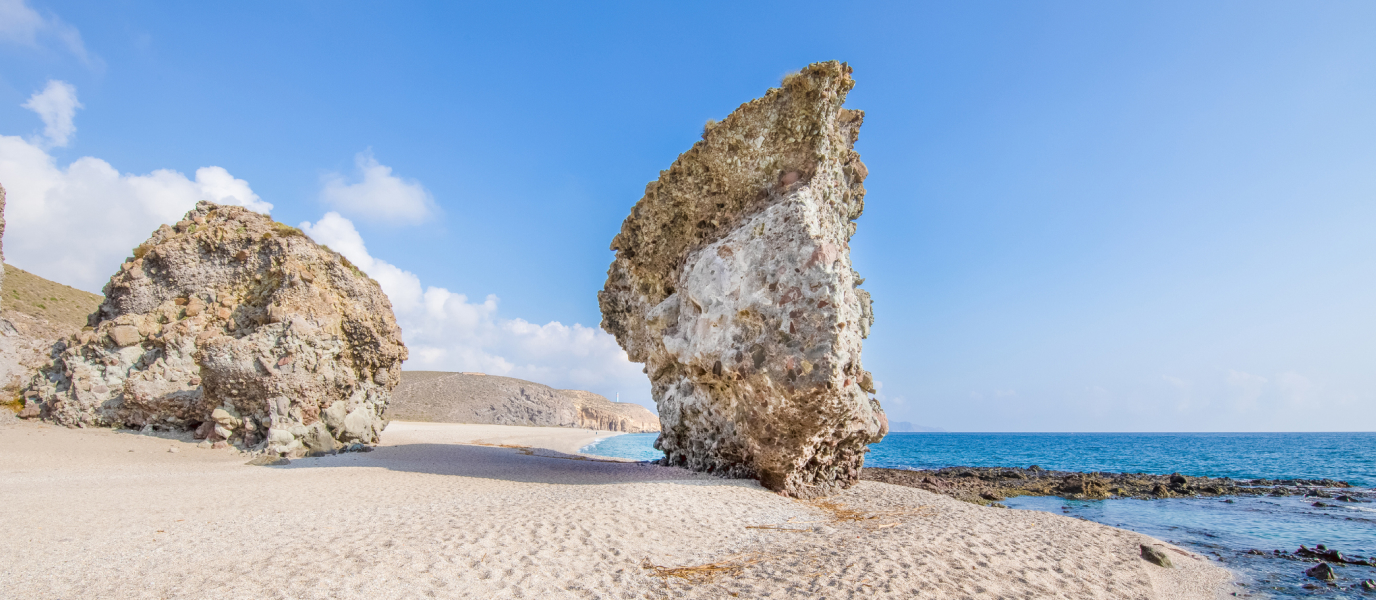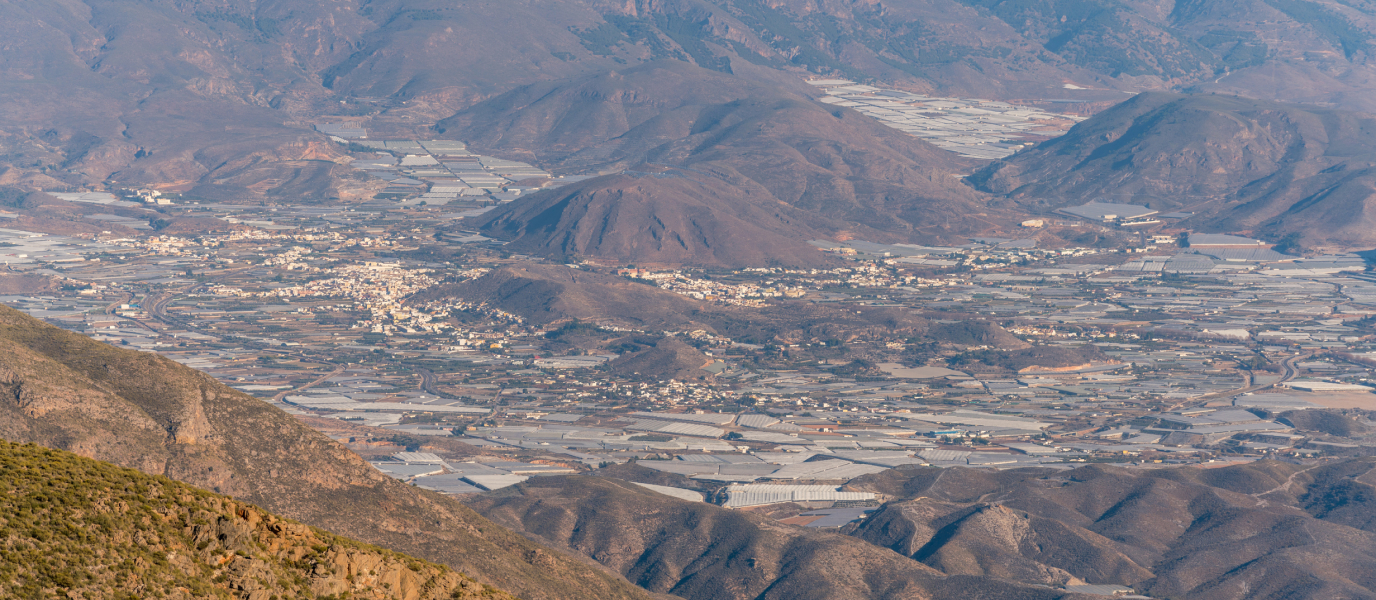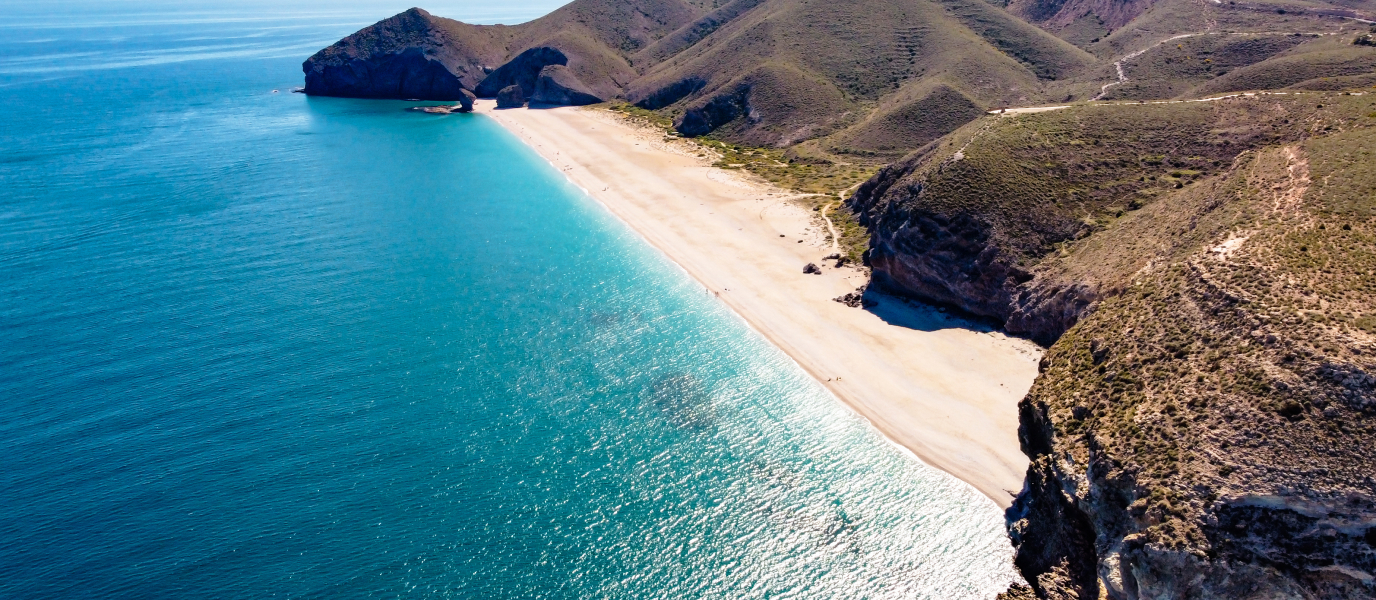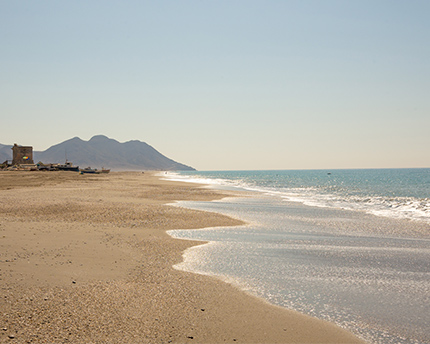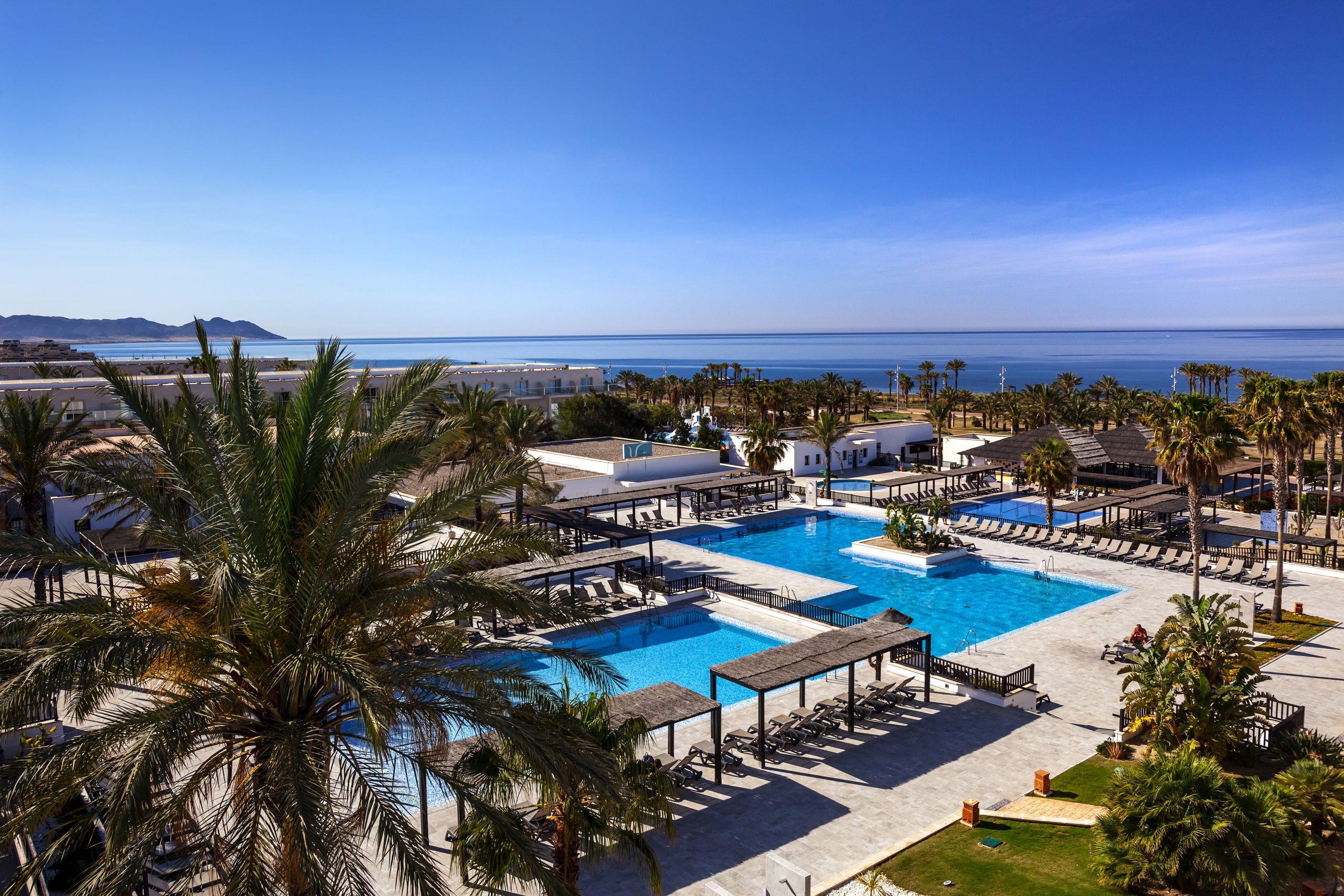The Parque Natural Cabo de Gata-Níjar is one of the most outstanding natural wonders in the province of Almería. This protected area is nature at its finest, and it boasts some of the best beaches in Spain.
The natural park stretches 65 km along the coast through the municipalities of Almería, Carboneras and Níjar (the latter has the most beaches). Cabo de Gata’s 54 sandy stretches include beaches, coves and other bathing spots.
The semi-arid climate in this Biosphere Reserve makes for a fantastic destination not just in summer but in spring and autumn too, when good weather is almost guaranteed. Remember that this is a protected natural area, which means most beaches have no facilities and minimal access points, except the few urban beaches in the region.
Related experiences
Playa de los Muertos
Playa de los Muertos is one of the most famous beaches in the Parque Natural Cabo de Gata-Níjar and usually ranks among the best beaches in Spain. You’ll find it in the municipality of Carboneras, at the eastern extreme of the natural park. The beach gets its name from shipwrecked seafarers whose bodies would wash up on this stretch of coast.
Playa de los Muertos is what’s known as a ‘mixed’ beach and nudism isn’t frowned upon. Take care when the eastern wind gets up – the waves can become very dangerous.
About Playa de los Muertos
- Length: 1,160 metres
- Width: 30-70 metres
- Type: fine shingle and white sand
- Access: tricky (expect an arduous trek)
Playa de los Genoveses
The virgin sands of Playa de los Genoveses provided the backdrop to some Westerns filmed in Almería. There are no modern buildings on this wild beach, situated as it is beside a dune system and surrounded by small hills, all of which makes Playa de los Genoveses astoundingly beautiful. This is undoubtedly one of the most famous beaches in the Parque Natural Cabo de Gata-Níjar. The iconic volcanic rock formation called the Morrón de los Genoveses rises 85 metres above the horizon where the sea meets the desert.
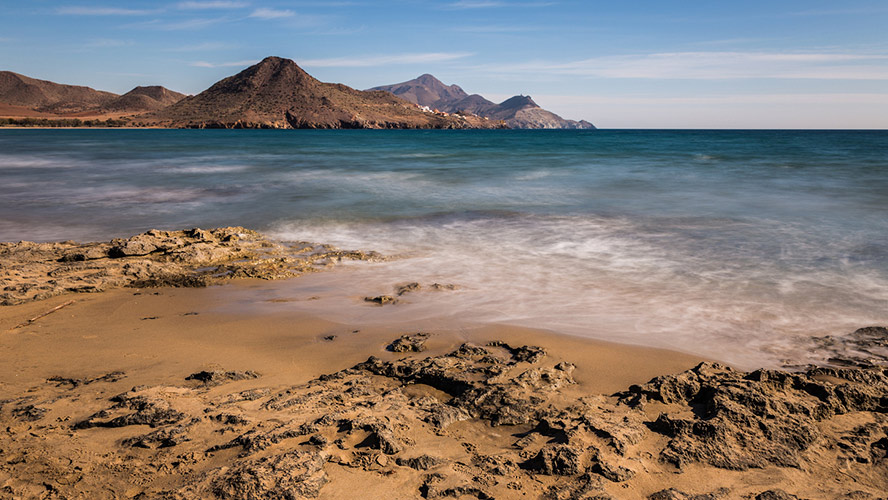
This beach in the municipality of Níjar is the most desert-like of all those in the region. Silence reigns supreme here (except in summer of course) and getting to the beach requires a bit effort, but the seclusion you’ll find there is worth it. During peak season access by car is restricted and a bus service is put on from San José.
About Playa de los Genoveses
- Length: 1,180 metres
- Width: 40-50 metres
- Type: fine golden sand
- Access: poor. Consider using the public bus in summer.
Playa de Mónsul
Separated from Playa de los Genoveses by a series of hidden coves is Playa de Mónsul, also in Níjar. This is another of the most secluded beaches in Cabo de Gata, and here the sand dunes and the craggy formation called the Peineta (or Comb) add a touch of magic to the scene.
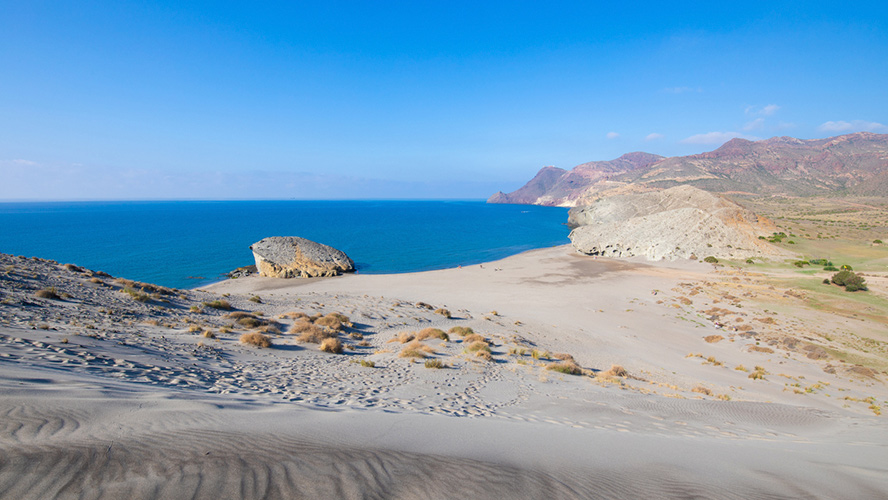
Playa de Mónsul is another of Almería’s locations to feature on the silver screen, providing the setting for scenes from Indiana Jones and the Last Crusade and Lawrence of Arabia. When you see it for yourself, you’ll understand why it’s so special and why it needs to be protected. We recommend getting to Playa de Mónsul using the public bus from San José.
About Playa de Mónsu
- Length: 300 metres
- Width: 50 metres
- Type: dark sand
- Access: poor. Consider using the public bus in summer.
Playazo de Rodalquilar
The small beach called Playazo de Rodalquilar has a colourful history. Keep your eyes peeled for historical relics, such as the Batería de San Ramón, a small fortress built in 1764 during the reign of Charles III of Spain. Further inland, the Torre de los Alumbres (1510) stands in ruins.
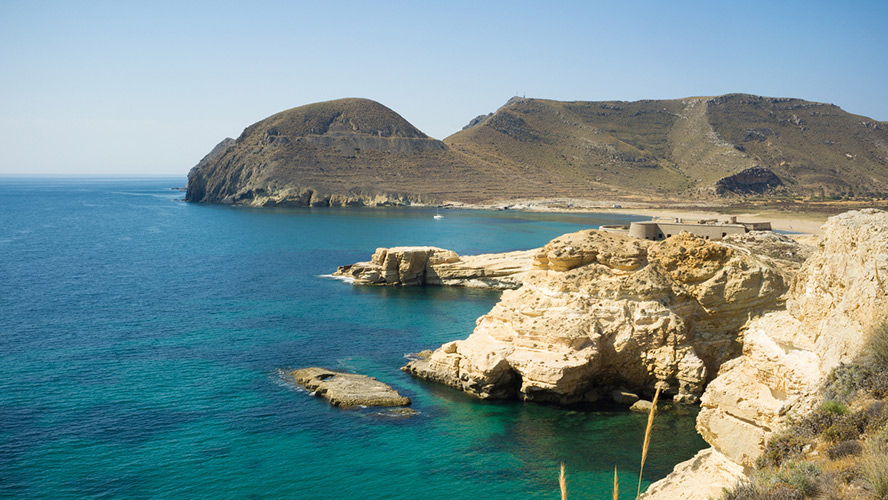
The Playazo is a great beach for families. Access is easier than at other beaches in Cabo de Gata and there’s more protection from the waves. Next to the fortress is a small sheltered cove for those looking to escape the crowds.
About Playa del Playazo de Rodalquilar
- Length: 400 metres
- Width: 30 metres
- Type: fine golden sand
- Access: easy
Playa de las Salinas
Playa de las Salinas, not far from the city of Almería, is the largest beach in the natural park. It runs along the straight stretch of coastline that joins the cape with the capital of the province, and gets its name from the historical salt mines which are still working today.
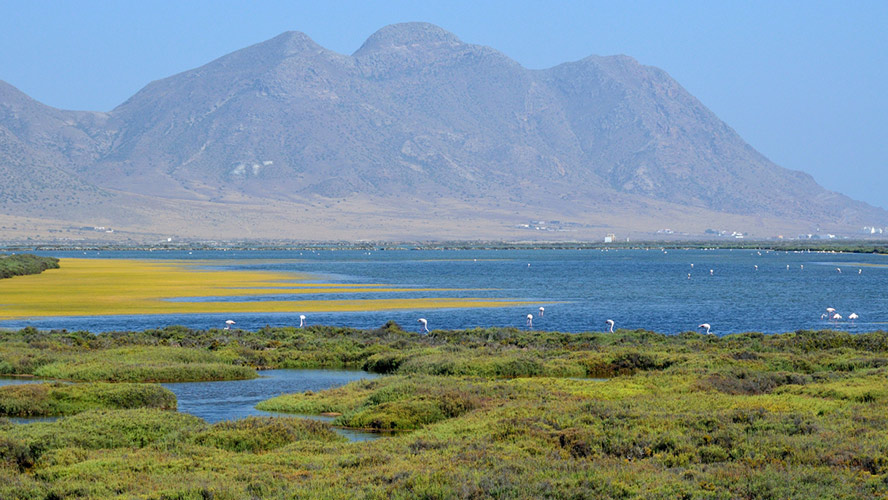
Families will love this beach: there are plenty of facilities in the nearby towns and villages as well as public transport and lots of space. Together with Playa de La Almadraba and Playa de La Fabriquilla, there are more than five kilometres of sand. Windsurfers will also be quite at home here.
About Playa de las Salinas
- Length: 2,500 metres
- Width: 100 metres
- Type: white sand and small pebbles
- Access: reasonable. There’s a road by the beach.
Playa de San José
If you prefer the comforts of an urban beach, this is the one for you. It’s the main beach in the San José area, not far from Playa de Mónsul and Playa de Los Genoveses.
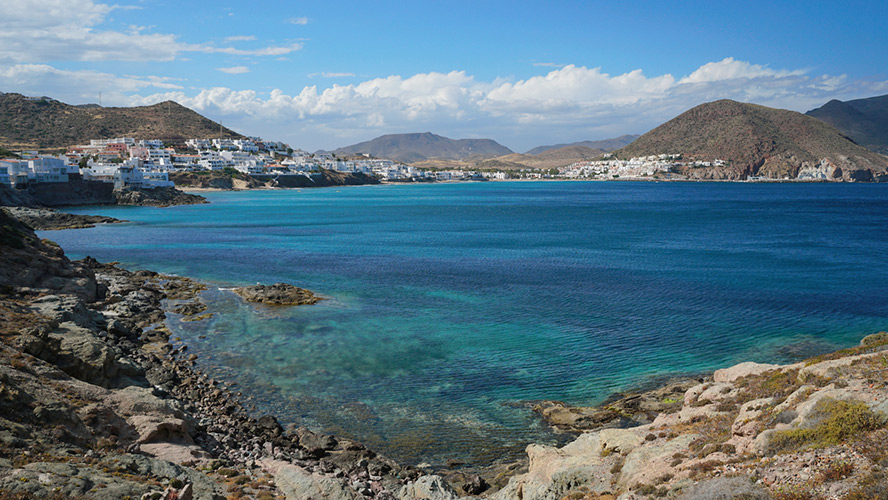
Playa de San José is popular and often busy. Choose from a range of activities including diving, scooter hire or kayaking. The beach has all the facilities you’d expect from an urban beach, such as showers, bars, lifeguards, football areas and a marina.
About Playa de San Jos
- Length: 850 metres
- Width: 40 metres
- Type of sand: golden.
- Access: adapted for people with reduced mobility.
Playa de las Negras
To the north of Playazo de Rodalquilar is the town of Las Negras and the beach of the same name, with crystalline waters and lot of shelter. Playa de las Negras is another urban beach in the Cabo de Gata area and it has a range of services nearby including accommodation, supermarkets, restaurants and tourist activities.
If you prefer something a little off the beaten track there are several hidden coves nearby. Try Cala del Cuervo, Cala Hernández or Cala de San Pedro.
About Playa de Las Negras
- Length: 800 metres
- Width: 25 metres
- Type: sand and small pebbles
- Access: adapted for people with reduced mobility.
Coves in Cabo de Gata
Aside from the few beaches we’ve highlighted so far, the area also has more than 50 spectacular sandy stretches between Almería, Níjar and Carboneras. The unique landscape of the province of Almería means there’s all sorts of beaches to choose from, whether the 5-km stretch of Las Salinas or small coves with just a few tens of metres of sand.
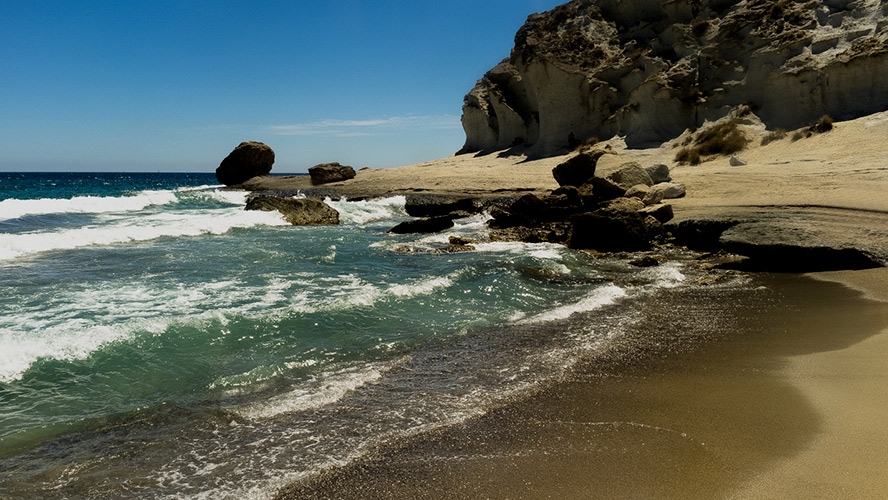
Hidden between headlands are some really special places, such as the tiny Cala de los Motores or the spectacular Cala de Enmedio, perhaps the most beautiful cove in the whole of Almería. For something really unique, head to the Arrecife de las Sirenas (Mermaid Reef) and experience a feeling of true remoteness in Cabo de Gata.
These are just a few examples, and the coast around the Parque Natural Cabo de Gata-Níjar has plenty more small beaches and coves where you can enjoy sun, sand and sea in tranquillity.
Nudist beaches in Cabo de Gata
Nudism is widely accepted on many of the beaches in Cabo de Gata, and the choice of coves and long sandy stretches means the coast in this part of Spain caters to all.
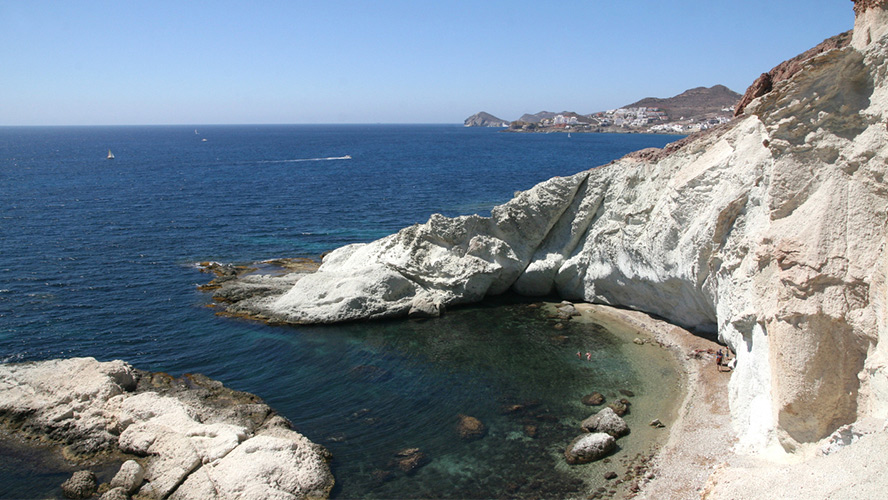
The Playazo is considered one of the best nudist beaches in all of Europe, and Playa de los Muertos, Playa de Los Genoveses and Playa de Mónsul all have designated nudist areas. However, there are plenty of other places where you can feel completely at ease. Here are a few:
- Playa de la Media Luna: Near Playa de Mónsul.
- Playa del Barronal: Between Mónsul and Los Genoveses. A spectacular beach hidden between the rocks.
- Cala Higuera: This cove is next to Playa de San José though enjoys some separation from the urban hub.
- Coves in the Vela Blanca area: Cala Arena, Cala Rajá and Cala Carbón. These are some of the most secluded coves along the coast and afford the utmost privacy. You’ll find them close to the Cabo de Gata lighthouse.



























































